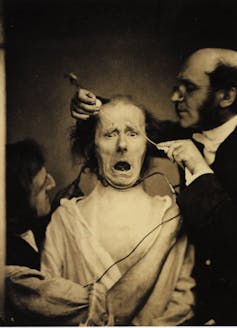Darwin Concluded From His Observations of Nature and Readings That
Was Charles Darwin a one-hit wonder? According to scientists who have a gene's-eye view of evolution, the 19th-century English naturalist contributed ane crucial idea to agreement how species change: natural selection, or "blueprint without a designer".
However, a volume of Darwin'south that is little read by modern evolutionists – The Expression of the Emotions in Man and Animals – turns out to contain valuable lessons for scientists seeking to understand how and why humans practice what we practise.
Published 150 years ago, the book has long bemused scientific readers because information technology hardly mentions natural option. Instead, it puts how organisms behave at the heart of evolutionary adaptation – an idea that is becoming commonplace in 21st-century biology.
Baca juga: Curious Kids: how practice scientists know evolution is real?
Putting agency into evolution
Since the 1940s, evolutionists have viewed natural selection as an aimless mechanism: random genetic variations arise, and chance environmental events allow the most benign (or "fittest") ones to survive.
More recently, biologists have found it necessary to introduce the actual behaviour of living creatures into this moving-picture show. From this perspective, organisms adapt to their circumstances, and genetics then stabilises the changes.
As I show in my book Darwin's Psychology, for Darwin, the agency of organisms – their power to do things – was the fundamental, whether in driving the struggle for existence, or in explaining the antics of climbing plants, babies and earthworms.
This was because actions produce reactions: what a creature does has consequences for itself and its surroundings.
Those consequences shape its own subsequent actions, and how its descendants eventually evolve.
Baca juga: Social plants: in the wild, staghorn ferns grow in colonies to ameliorate water storage for all members
Some consequences prove injurious or fatal. Others enhance the doer's life, even if it is in ways that are non immediately obvious, such as forest trees and honeybees who render "mutual aid" to other members of their ain species.
Darwin took this view of bureau and applied it to what he called the most social of social species, ourselves.
Expressions and significant

He analysed in cracking item more than 70 dissimilar components and types of facial expressions plus other non-facial gestures.
Darwin ended the movements nosotros telephone call expressions, such as smiling and crying, did not evolve to communicate. For Darwin, smiles and tears practice not arrive at the body'south surface already steeped in emotional meanings brewed in the subconscious recesses of the expresser's heed. They are accidental side-effects of other "habits", or of the means the nervous system works.
"Expressions" simply get meaningful when others read them as such, then the meaning of any and then-chosen "emotional expression" depends on context and other people.
Viewed this way, Darwin'southward volume argues an expression could just ever have evolved or "become instinctive" if the ability to recognise it had also evolved and "likewise become instinctive". And if recognising expressions is instinctive, Darwin reasoned, humans should exist born able to empathise gestures and facial displays.
Child's play
To find out whether this was the case, Darwin advisedly studied the social behaviour of his firstborn child, Doddy. He observed Doddy understood, "at a very early menstruum, the meaning or feelings" of those who took intendance of him, "by the expression of their features".

Darwin tells united states he aimed many "odd noises and strange grimaces" at his four-month-old son. These did not scare Doddy, nevertheless, being "taken as practiced jokes", because they were "preceded or accompanied by smiles" – the smiles proving legible to Doddy as making humorous his father's otherwise-fearsome growling and gurning.
These observations pre-empted by more than than a century mod psychology'southward discovery babies accept an inbuilt capacity for sympathetic heed-reading and mental sharing.
Universal emotions?
Darwin fabricated clear his book presented a theory of expression rather than a theory of emotion. While he painstakingly pioneered a mod physiological way of studying the homo movements information technology discusses, he plant the meanings of such movements – whether emotional or not – to be inescapably social.
Modern psychologists argue over a dissever between supposedly "basic", "biological" or "universal" emotions such equally acrimony, which are held to exist direct linked to one'due south concrete state, and "social" emotions such as envy, which are supposed to result from our readings of others.
Darwin'due south work sidesteps this controversy, arguing merely the appreciable patterns of facial activeness we phone call "expressions" tin ever be universal. Whatever meanings are attributed to those actions must derive from the social relationships they reflect.
Reading faces

In Darwin'southward fourth dimension, the traditional way of studying emotions was to enquire people nearly why they were smiling or what they were angry about. However, Darwin's inquiry went the reverse way: he asked people near how they understood the expressions of others.
He asked expatriate Europeans living on six continents to make full in a survey about the forms of expressive motility they had seen in diverse indigenous peoples "who have associated just little with Europeans".
He also asked twenty or so well-educated members of his circle to judge what meanings they saw in photographs of xi facial displays neurologist Guillaume Duchenne had produced by attaching electrodes to muscles in the faces of volunteers then as to simulate different emotional expressions.
Darwin held that only photographs which judges agreed nearly could be chosen "genuine" expressions. Pictures of terror, sorrow or laughter produced unanimous responses. Other photos, including Duchenne'south portrait of hatred, proved indecipherable.
Blushing
The masterstroke of The Expression of the Emotions in Man and Animals comes in its longest chapter, on blushing. Blushes, Darwin shows, event from the rebounding of our kinesthesia for reading others: it is "the thinking what others recall of us which excites a blush".
Thus blushers will chroma when they imagine someone blames them for something, even when they are innocent. This conclusion, that one'due south reading of others' attitudes shapes how 1 acts, underpins the treatments of conscience and morality, sexual coquetry and civilization which fill Darwin'southward earlier book The Descent of Man (1871).
It as well inspired social theorist George Herbert Mead's invention of what sociologists now call "symbolic interactionism" – the view that all human actions are shaped by what they signify in the groups where they occur.
Read alongside The Descent of Man, of which it was at outset intended to form office, The Expression of the Emotions proves that Darwin'southward vision of nature equally a theatre of agency did more than anticipate biological science's newest theory of accommodation. That aforementioned vision laid the background for an idea of psychology based in evolution, where all human meaning has a social origin.
Baca juga: Guide to the classics: Darwin's The Descent of Man 150 years on — sex activity, race and our 'lowly' ape ancestry
knutsonintentookey.blogspot.com
Source: https://theconversation.com/150-years-ago-charles-darwin-wrote-about-how-expressions-evolved-pre-empting-modern-psychology-by-a-century-170880
0 Response to "Darwin Concluded From His Observations of Nature and Readings That"
Post a Comment